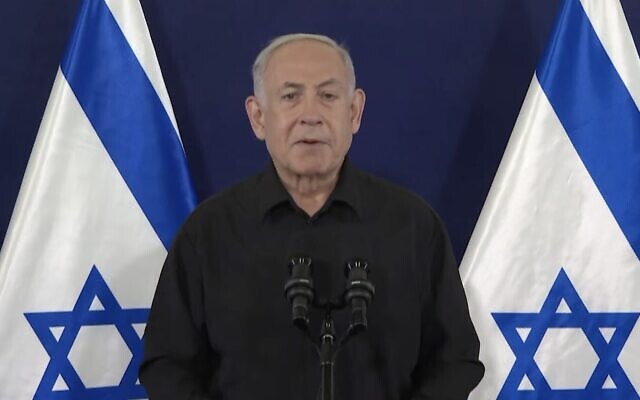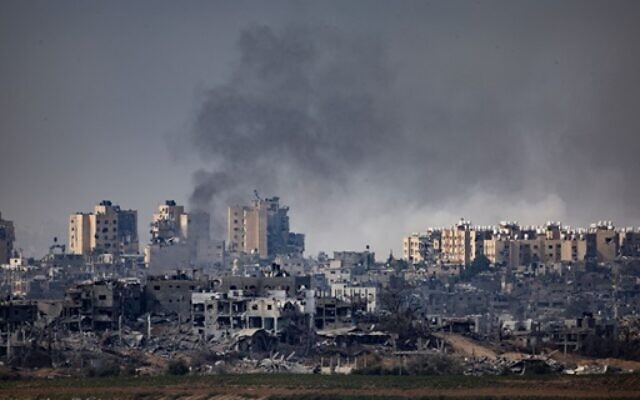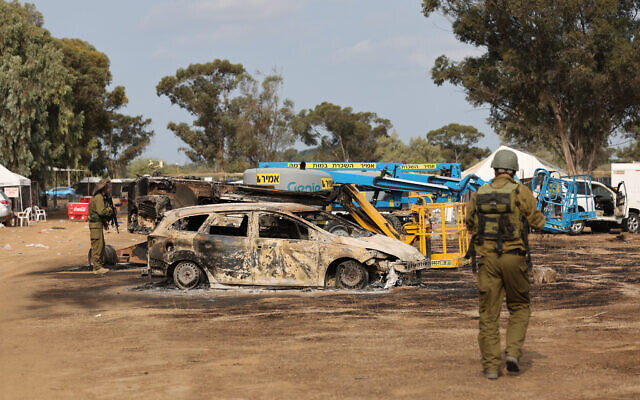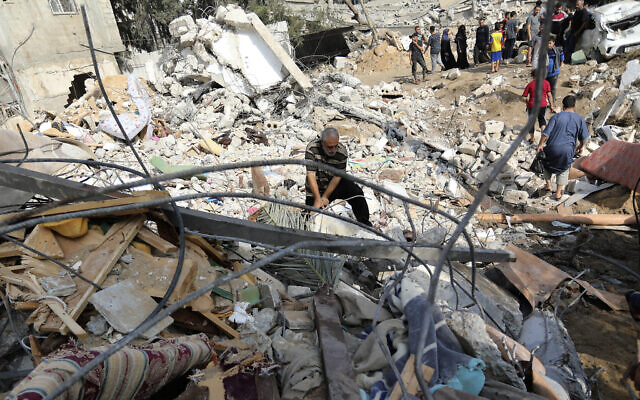What We Know About the Hostage Deal to Release Israelis Held by Hamas
The deal expected on Tuesday would free children, women and some of the oldest hostages in exchange for women and youths held by Israel on national security charges and would trigger a pause in the war between Israel and Hamas.

(JTA) — When it attacked Israel on Oct. 7, killing 1,200 people and wounding thousands, Hamas also took an estimated 240 people hostage. Following weeks of breathless advocacy, protest and anxiety that spread across the world, some of those captives are about to be released in a deal between Israel and Hamas.
The hostages range from Israeli soldiers to the elderly to small children. The deal expected on Tuesday would free children, women and some of the oldest hostages in exchange for women and youths held by Israel on national security charges and would trigger a pause in the war between Israel and Hamas. It would be Israel’s first prisoner exchange with Hamas in more than a decade and by far the largest in history.
The agreement is a milestone in what has become a worldwide campaign, led by the captives’ relatives, to raise awareness of their plight and push for their release. The movement has seen cities across the globe papered with posters bearing the hostages’ faces and names (many of which have been taken down) and empty Shabbat dinner tables set up from Tel Aviv to New York City’s Times Square to represent the captives. A call to release the hostages was a central demand of the rally that brought more than 200,000 Jews to a rally in Washington, D.C. last week.
And the deal may be just the first stage in ongoing negotiations to bring the six-week-old war to an end. Here’s what you need to know about the impending agreement, what it might mean and what we still don’t know.
How many hostages will be released and who are they?
Under the reported deal, 50 hostages will be released each day during the initial pause, likely starting on Friday. Afterward, Hamas can extend the truce by releasing an additional 10 hostages a day. Up to 80 hostages could be released.

The first tranche of hostages to be released will include children held by Hamas — a number Israel estimates at 40. They include a 10-month-old baby and his 4-year-old sister, Kfir and Ariel Bibas; Abigail Mor Idan, 3, a U.S. citizen who is being held without anyone else in her family; Emily Hand, whose parents first believed her to be dead and who just turned 9 in captivity; Erez and Sahar Kalderon, whose grandmother and cousin were murdered; and Yigal Yaakov, 13, who appeared in a hostage video released earlier this month.
Israel reportedly pressed hard for mothers to be released with their children, and Israeli reports suggest that demand is being met. Elderly women who are held hostage are also expected to be released as part of the deal.
What about the rest of the hostages?
About a month ago, Hamas released two women, ages 79 and 85; the husband of one of them is still being held by Hamas. Hamas also released an American mother and daughter last month. Neither of those releases was subject to an agreement with Israel. Israel rescued one hostage, a soldier, on Oct. 30.
In addition, some of the hostages are known to have died after being taken captive. Others were severely injured before being abducted to Gaza. The condition and location of the remaining hostages may not easily be known. Even those who are alive could be hard to find, in a region where the vast majority of people have been displaced since Oct. 7.
Some of the hostages are soldiers and do not appear to be represented in the deal at all. It also appears that adult men who are not soldiers are not set for imminent release.
Notably, the deal applies only to Israeli hostages. Perhaps dozens of the hostages are foreign nationals who were in Israel as guest workers, including Thai and Filipino citizens and students from Tanzania. (One of them, Clemence Matanga, died in Gaza.) Hamas also took about a dozen U.S. citizens hostage, though most if not all hold Israeli citizenship as well.

Some hostages are not in Hamas’ control. Hostages were held by three different terrorist groups in Gaza: Hamas, Palestinian Islamic Jihad and a smaller militia. Negotiations have involved only Hamas, which controls Gaza. According to Israeli reports, only 30 of the estimated 40 child hostages are being held by Hamas.
What is Israel giving up to get the hostages back?
According to the contours of the deal reported by Israeli media, Israel will release three Palestinian prisoners for every hostage released, meaning that up to 240 Palestinians will go free. That represents only a tiny fraction of the approximately 5,000 Palestinians held in Israeli prisons prior to Oct. 7.
It’s also a much smaller number than the 1,000 prisoners Israel released in 2011 in exchange for Gilad Shalit, a soldier who Hamas had taken hostage five years earlier. As opposed to the 2011 exchange, this time Israel says it has agreed only to release women and minors who did not kill anyone.
Israel is also agreeing to pause its offensive in Gaza for at least four days and to suspend aerial surveillance for six hours a day during that time, in part so Hamas can locate additional hostages. Israeli soldiers will remain in northern Gaza, which they invaded last month, during the pause.
The number of trucks bringing in humanitarian aid during the pause will increase under the terms of the deal. Two weeks ago, Israel began allowing 100 trucks a day into Gaza, a goal the United States had laid out. Under the deal, that number will increase to 200 a day.
How will this affect Israel’s war against Hamas?
A big question is whether and to what extent Israel’s war in Gaza will continue after this group of hostages are released. Israel says it plans to resume fighting as soon as the truce expires. But a provision in the reported terms of the deal allows for an extension of the truce if Hamas releases more hostages — 10 freed captives for each additional day of calm.

A lot can happen during a pause in fighting: Both sides can regroup, but there could also be continued talks that would lay the groundwork for a more lasting cessation of hostilities — something protesters around the world and a small but growing group of Democratic lawmakers in the United States support. Israel has so far rejected calls for a permanent ceasefire because its stated goal is to depose Hamas.
Previous Israel-Hamas humanitarian pauses have also been broken — plunging both sides back into the fighting.
Plus, international sentiment that has been firmly on Israel’s side up to now could shift. Some, though not all, of Israel’s goals have been met, and a pause in the fighting may allow humanitarian groups to assess the devastation. Already, the United States is signaling that it may not support an expansion of Israel’s military campaign in southern Gaza without stronger assurances from Israel that it will protect civilians.
According to the Hamas-run Gaza Health Ministry, more than 12,000 Palestinians have been killed in the fighting, though the number does not distinguish between civilians and combatants, and does not say how many have been killed by misfired Palestinian rockets.
Who helped broker the deal?
Both the United States and Qatar acted as go-betweens for Israel and Hamas, which refuse to negotiate directly. Both are already involved in the fighting: The United States has stood firmly behind Israel’s military campaign in Gaza and provides it with aid, while Qatar is the home base of Hamas’ political leadership.
This is far from the first time Israel and Hamas have conducted indirect negotiations. During their last major round of conflict, in 2021, Egypt brokered a ceasefire with the support of Jordan and the United States.
Does everyone in Israel support the deal?
No. Members of the far-right bloc in the government said they oppose a deal, calling it short-sighted. The Religious Zionist party, led by Bezalel Smotrich, issued a statement calling it “bad for Israel’s security, bad for the hostages, and bad for the soldiers of the IDF.”
Their argument is that sending Palestinian prisoners back into Gaza lays the groundwork for future attacks. Yahya Sinwar, the mastermind of Oct. 7, was released from an Israeli prison in the 2011 prisoner exchange. The far-right lawmakers also say Israel will be demonstrating that it is willing to make compromises to win back hostages, potentially raising the cost to get the rest of the hostages out.
Family members of the hostages have clashed with the far right in calling for their relatives’ release. At a meeting in Israel’s parliament this week, far-right legislators yelled at family members of the hostages and one accused them of supporting Hamas.
Other right-wing parties have said they will support the deal, giving it far more than enough support to clear a government vote.



comments